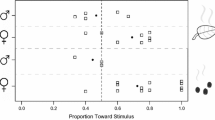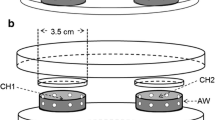Abstract
A population of the diamondback moth Plutella xylostella (L.) (Lepidoptera: Plutellidae) (DBM) was recently found to infest sugar snap- and snowpeas in the Rift Valley in Kenya, causing heavy damage. The influence of this host shift on host location preferences of two parasitoids was investigated: The indigenous Diadegma mollipla (Holmgren) regarded as a relative generalist, and Diadegma semiclausum(Hellen), regarded as highly specific to DBM. The attractiveness of different odour sources was compared for the two parasitoid species using a Y-tube olfactometer using naïve females. D. mollipla was not significantly attracted to any cabbage related odours but showed a significant preference for the DBM infested pea plant when tested against clean air. D. semiclausum was highly attracted to the undamaged cabbage plant and odours related to cabbage. On the other hand, peas infested with DBM, showed no attractiveness to this parasitoid. The results showed that specialisation of D. semiclausum is mediated by host plant signals, associated with crucifers, which are not encountered in DBM feeding on peas. For D. mollipla,although a frequent parasitoid on DBM in crucifers, volatiles emitted by these plants might not be used as primary cues for host location. This species may respond largely to chemicals yet unknown and associated with a variety of plant-herbivore interactions.
Similar content being viewed by others
References
Abbas, M. S. T. (1988). Biological and ecological studies on Diadegma semiclausum Hellen (Hym., Ichneumonidae), a larval parasite of the diamondback moth, Plutella xylostella (L.) (Lep., Plutellidae) in Egypt. Anz. Schaedlingskde, Pflanzenschutz, Umweltschutz 61: 1–2.
Akol, A. M., Njagi, P. G. N., Sithanantham, S., and Mueke, J. M. (2003). Effects of two neem insecticide formulations on the attractiveness, acceptability and suitability of diamondback moth larvae to the parasitoid, Diadegma mollipla (Holmgren) (Hym., Ichneumonidae). J. Appl. Ent. 127: 325–331.
Auger, J., Lecomte, C., Paris, J., and Thibout, E. (1989) Identification of leek moth and DBM frass volatiles that stimulate the parasitoid Diadromus pulchellus. J. Chem. Ecol. 15: 1391–1398.
Azidah, A. A., Fitton, M. G., and Quicke, D. L. J. (2000). Identification of the Diadegmaspecies (Hymenoptera: Ichneumonidae, Campopleginae) attacking the diamondback moth, Plutella xylostella (Lepidoptera: Plutellidae). Bull. Entomol. Res.90: 375–389.
Bogahawatte, C. N. L., and Van Emden, H. F. (1996). The influence of the host plant of diamondback moth (Plutella xylostella) on the plant preferences of its parasitoid Cotesia plutellae in Sri Lanka. Physiol. Entomol. 21: 93–96.
Bottrell, D. G., Barbosa, P., and Gould, F. (1998). Manipulating natural enemies by plant variety selection and modification: A realistic strategy? Annu. Rev. Entomol. 43: 347–367.
Bradburne, R. P., and Mithen, R. (2000). Glucosinolate genetics and the attraction of the aphid Diaeretiella rapae to Brassica. Proc. R. Soc. Lond. B Biol. Sci. 267: 89–95.
Broodryk, S. W. (1971). The biology of Diadegma stellenboschense (Cameron) (Hymenoptera: Ichneumonidae), a parasitoid of potato tuber moth. J. Ent. Soc. Sth. Afr.34: 413–423.
Davis, A. J., (1987). Effects of experiences and kairomones on searching behaviour of Diadegma eucerophaga (Ichneumonidae) for Plutella xylostella (Plutellidae) on Brassica plants. J. Med. Fac. Landbouww. Rijksuniv. Gent. 52(2a): 403–411.
Dicke, M., and van Loon, J. J. A. (2000). Multitrophic effects of herbivore-induced plant volatiles in an evolutionary context. Entomol. Exp. Appl. 97: 237–249.
Dicke, M. (1994). Local and systemic production of volatile herbivore induced terpenoids: their role in plant-carnivore mutualism. J. Plant Physiol. 143: 465–472.
Geervliet, J. B. F., Vet, L. E. M., and Dicke, M. (1994). Volatiles from damaged plants as major cues in long-range host searching by the specialist parasitoid Cotesia rubecula. Entomol. Exp. Appl. 73: 289–297.
Godfray, H. C. J. (1994). Parasitoids. Behavioral and Evolutionary Ecology. Monographs in Behavior and Ecology. Princeton Univ. Press, Princeton.
Gupta, V. K. (1974). Studies on certain porizontine ichneumonids reared from economic hosts (parasitic hymenoptera). Orient. Insects 3: 99–116.
Havill, N. P., and Raffa, K. F. (2000). Compound effects of induced plant responses on insect herbivores and parasitoids: Implications for tritrophic interactions. Ecol. Entomol. 25: 171–179.
Löhr, B., and Rossbach, A. (2004). Diamondback moth, Plutella xylostella (L.) on peas in Kenya: Impact of the host shift on the pest and its parasitoid. 4th Int. Workshop on the Management of DBM and other crucifer pests, Melbourne 2001, pp 133–139.
Löhr, B. (2001). Diamondback moth on peas, really. Biocontrol News andInformation19: 38N–39N.
Murchie, A. K., Smart, L. E., and Williams, I. H. (1997). Responses of Dasineura brassicae and its parasitoids Platygaster subuliformis and Omphale clypealis to field traps baited with organic isothiocyanates. J. Chem. Ecol. 23: 917–926.
Ngi-Song, A. J., Njagi, P. G. N., Torto, B., and Overholt, W. A. (2000). Identification of behaviourally active components from maize volatiles for the stemborer parasitoid Cotesia flavipes Cameron (Hymenoptera: Braconidae). Insect Sci. Appl. 20: 181–189.
Ngi-Song, A. J., Overholt, W. A., Njagi, P. G. N., Dicke, M., Ayertey, J. N., and Lwande, W. (1996). Volatile infochemicals used in host and host habitat location by Cotesia flavipes Cameron and Cotesia sesamiae (Cameron) (Hym.; Braconidae), larval parasitoids of stemborers on Graminae. J. Chem. Ecol. 22: 307–323.
Ohara, Y., Akio, T., and Takabayashi, J. (2003). Response to host-infested plants in females of Diadegma semiclausum Hellen (Hymenoptera: Ichneumonidae). Appl. Entomol. Zool. 38: 157–162.
Pivnick, K. A., Blair, J. J., and Slater, G. P. (1994). Identification of olfactory cues used in host-plant finding by diamondback moth, Plutella xylostella (Lepidoptera: Plutellidae). J. Chem. Ecol. 20: 1407–1427.
Potting, R. P. J., Poppy, G. M., and Schuler, T. H. (1999). The role of volatiles from cruciferous plants and pre-flight experience in the foraging behaviour of the specialist parasitoid Cotesia plutellae. Entomol. Exp. Appl. 93: 87–95.
Reddy, G. V. P., Holopainen, J. K., and Guerrero, A. (2002). Olfactory responses of Plutella xylostella natural enemies to host pheromone, larval frass and green leaf cabbage volatiles. J. Chem. Ecol. 28: 131–143.
Shiojiri, K., Takabayashi, J., Yano S., and Takafuji, A. (2000). Flight response of parasitoids toward plant-herbivore complexes: A comparative study of two parasitoid-herbivore systems on cabbage plants. Appl. Entomol. Zool. 35: 87–92.
Steidle, J. L. M., and van Loon, J. J. A. (2003). Dietary specialization and infochemical use in carnivorous arthropods: testing a concept. Entomol. Exp. Appl. 108: 133–148.
Steidle, J. L. M., Steppuhn, A., and Ruther, J. (2003). Specific foraging kairomones used by a generalist parasitoid. J. Chem. Ecol. 29: 131–143.
Takabayashi, J., Sato, Y., Horikoshi, M., Yamaoka, R., Yano, S., Ohsaki, N., and Dicke, M. (1998). Plant effects on parasitoid foraging: Differences between two tritrophic systems. Biol. Contol 11: 97–103.
Talekar, N. S., and Shelton, A. M. (1993). Biology, ecology, and management of the diamondback moth. Annu. Rev. Entomol. 38: 275–301.
Verkerk, R. H. J., and Wright, D. J. (1996). Multitrophic interactions and management of the diamondback moth: A review. Bull. Entomol. Res. 86: 205–216.
Vet, L. E. M., and Dicke, M. (1992). Ecology of infochemical use by natural enemies in a tritrophic context. Annu. Rev. Entomol. 37: 141–172.
Vinson, B. S. (1976). Host selection by insect parasitoids. Ann. Rev. Entomol. 21: 109–133.
Wang, X.-G., and Keller, M. A. (2002). A comparison of the host-searching efficiency of two larval parasitoids of Plutella xylostella. Ecol. Entomol. 27: 105–114.
Xu, J, Shelton, A. M., and Cheng, X. (2001). Comparison of Diadegma insulare (Hymenoptera: Ichneumonidae) and Microplitis plutellae (Hymenoptera: Braconidae) as biological control agents of Plutella xylostella (Lepidoptera: Plutellidae): Field parasitism, insecticide susceptibility, and host searching. J. Econ. Ent. 94: 14–20.
Author information
Authors and Affiliations
Corresponding author
Rights and permissions
About this article
Cite this article
Roßbach, A., Löhr, B. & Vidal, S. Generalism Versus Specialism: Responses of Diadegma mollipla (Holmgren) and Diadegma semiclausum (Hellen), to the Host Shift of the Diamondback Moth (Plutella xylostella L.) to Peas. J Insect Behav 18, 491–503 (2005). https://doi.org/10.1007/s10905-005-5607-9
Revised:
Accepted:
Issue Date:
DOI: https://doi.org/10.1007/s10905-005-5607-9




